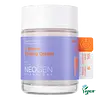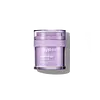What's inside
What's inside
 Key Ingredients
Key Ingredients

 Benefits
Benefits

 Concerns
Concerns

 Ingredients Side-by-side
Ingredients Side-by-side

Water
Skin ConditioningGlycerin
HumectantCaprylic/Capric Triglyceride
MaskingPanthenol
Skin ConditioningButylene Glycol
HumectantPropanediol
SolventNiacinamide
Smoothing1,2-Hexanediol
Skin ConditioningDiisostearyl Malate
EmollientCoco-Caprylate/Caprate
EmollientHydrogenated Poly(C6-14 Olefin)
EmollientMalva Sylvestris Flower Extract
Skin ConditioningStearyl Alcohol
EmollientNeopentyl Glycol Diheptanoate
EmollientHydrogenated Olive Oil Lauryl Esters
Emulsion StabilisingPolyglyceryl-2 Stearate
EmulsifyingCetyl Alcohol
EmollientGlyceryl Stearate
EmollientHydroxyethyl Acrylate/Sodium Acryloyldimethyl Taurate Copolymer
Emulsion StabilisingPolyglyceryl-10 Laurate
Skin ConditioningHydrogenated Lecithin
EmulsifyingDimethicone
EmollientAcrylates/C10-30 Alkyl Acrylate Crosspolymer
Emulsion StabilisingTromethamine
BufferingAnthemis Nobilis Flower Oil
MaskingEthylhexylglycerin
Skin ConditioningXanthan Gum
EmulsifyingThuja Occidentalis Leaf Oil
MaskingAdenosine
Skin ConditioningSorbitan Isostearate
EmulsifyingLactococcus Ferment Lysate
Skin ConditioningCoptis Japonica Extract
AntimicrobialAscorbic Acid
AntioxidantCitrus Aurantium Amara Flower Extract
RefreshingCollagen Extract
Skin ConditioningCyanocobalamin
Skin ConditioningMaltodextrin
AbsorbentMagnesium Ascorbyl Phosphate
AntioxidantAscorbyl Tetraisopalmitate
AntioxidantSodium Starch Octenylsuccinate
AbsorbentCalcium Pantothenate
Sodium Ascorbyl Phosphate
AntioxidantPolyglyceryl-10 Diisostearate
EmulsifyingGardenia Florida Fruit Extract
Skin ConditioningSodium Polyphosphate
Tocopheryl Acetate
AntioxidantPyridoxine Hcl
Skin ConditioningSodium Ascorbate
AntioxidantLecithin
EmollientPolysorbate 20
EmulsifyingMenadione
MaskingTricalcium Phosphate
AbrasiveSilica
AbrasiveCopper Tripeptide-1
Skin ConditioningBiotin
AntiseborrhoeicPyridoxine
Skin ConditioningFolic Acid
Skin ConditioningTocopherol
AntioxidantTripeptide-1
Skin ConditioningRiboflavin
Cosmetic ColorantThiamine Hcl
MaskingPalmitoyl Tripeptide-1
Skin ConditioningLinoleic Acid
CleansingTripeptide-2
Skin ConditioningHexapeptide-1
Skin ConditioningBeta-Carotene
Skin ConditioningAcetyl Hexapeptide-8
HumectantPalmitoyl Tetrapeptide-7
Skin ConditioningPalmitoyl Pentapeptide-4
Skin ConditioningHexapeptide-9
Skin ConditioningNonapeptide-1
Skin ConditioningDisodium EDTA
Water, Glycerin, Caprylic/Capric Triglyceride, Panthenol, Butylene Glycol, Propanediol, Niacinamide, 1,2-Hexanediol, Diisostearyl Malate, Coco-Caprylate/Caprate, Hydrogenated Poly(C6-14 Olefin), Malva Sylvestris Flower Extract, Stearyl Alcohol, Neopentyl Glycol Diheptanoate, Hydrogenated Olive Oil Lauryl Esters, Polyglyceryl-2 Stearate, Cetyl Alcohol, Glyceryl Stearate, Hydroxyethyl Acrylate/Sodium Acryloyldimethyl Taurate Copolymer, Polyglyceryl-10 Laurate, Hydrogenated Lecithin, Dimethicone, Acrylates/C10-30 Alkyl Acrylate Crosspolymer, Tromethamine, Anthemis Nobilis Flower Oil, Ethylhexylglycerin, Xanthan Gum, Thuja Occidentalis Leaf Oil, Adenosine, Sorbitan Isostearate, Lactococcus Ferment Lysate, Coptis Japonica Extract, Ascorbic Acid, Citrus Aurantium Amara Flower Extract, Collagen Extract, Cyanocobalamin, Maltodextrin, Magnesium Ascorbyl Phosphate, Ascorbyl Tetraisopalmitate, Sodium Starch Octenylsuccinate, Calcium Pantothenate, Sodium Ascorbyl Phosphate, Polyglyceryl-10 Diisostearate, Gardenia Florida Fruit Extract, Sodium Polyphosphate, Tocopheryl Acetate, Pyridoxine Hcl, Sodium Ascorbate, Lecithin, Polysorbate 20, Menadione, Tricalcium Phosphate, Silica, Copper Tripeptide-1, Biotin, Pyridoxine, Folic Acid, Tocopherol, Tripeptide-1, Riboflavin, Thiamine Hcl, Palmitoyl Tripeptide-1, Linoleic Acid, Tripeptide-2, Hexapeptide-1, Beta-Carotene, Acetyl Hexapeptide-8, Palmitoyl Tetrapeptide-7, Palmitoyl Pentapeptide-4, Hexapeptide-9, Nonapeptide-1, Disodium EDTA
Water
Skin ConditioningGlycerin
HumectantTetrahexyldecyl Ascorbate
AntioxidantDimethicone
EmollientPolyacrylamide
4-Butylresorcinol
AntioxidantHexapeptide-2
BleachingAllantoin
Skin ConditioningHydrolyzed Brassica Napus Seedcake Extract
Skin ConditioningTremella Fuciformis Sporocarp Extract
AntioxidantSqualane
EmollientDipotassium Glycyrrhizate
HumectantPentylene Glycol
Skin ConditioningButylene Glycol
HumectantDimethicone Crosspolymer
Emulsion StabilisingC13-14 Isoparaffin
EmollientCeramide NP
Skin ConditioningCeramide AP
Skin ConditioningCeramide EOP
Skin ConditioningLinoleic Acid
CleansingLinolenic Acid
CleansingPhytosphingosine
Skin ConditioningCholesterol
EmollientSodium Lauroyl Lactylate
EmulsifyingXanthan Gum
EmulsifyingCarbomer
Emulsion StabilisingCetearyl Olivate
Sorbitan Olivate
EmulsifyingLaureth-7
EmulsifyingCaprylyl Glycol
EmollientHexylene Glycol
EmulsifyingEthylhexylglycerin
Skin ConditioningPhenoxyethanol
PreservativeWater, Glycerin, Tetrahexyldecyl Ascorbate, Dimethicone, Polyacrylamide, 4-Butylresorcinol, Hexapeptide-2, Allantoin, Hydrolyzed Brassica Napus Seedcake Extract, Tremella Fuciformis Sporocarp Extract, Squalane, Dipotassium Glycyrrhizate, Pentylene Glycol, Butylene Glycol, Dimethicone Crosspolymer, C13-14 Isoparaffin, Ceramide NP, Ceramide AP, Ceramide EOP, Linoleic Acid, Linolenic Acid, Phytosphingosine, Cholesterol, Sodium Lauroyl Lactylate, Xanthan Gum, Carbomer, Cetearyl Olivate, Sorbitan Olivate, Laureth-7, Caprylyl Glycol, Hexylene Glycol, Ethylhexylglycerin, Phenoxyethanol
Ingredients Explained
These ingredients are found in both products.
Ingredients higher up in an ingredient list are typically present in a larger amount.
Butylene Glycol (or BG) is used within cosmetic products for a few different reasons:
Overall, Butylene Glycol is a safe and well-rounded ingredient that works well with other ingredients.
Though this ingredient works well with most skin types, some people with sensitive skin may experience a reaction such as allergic rashes, closed comedones, or itchiness.
Learn more about Butylene GlycolDimethicone is a type of synthetic silicone created from natural materials such as quartz.
What it does:
Dimethicone comes in different viscosities:
Depending on the viscosity, dimethicone has different properties.
Ingredients lists don't always show which type is used, so we recommend reaching out to the brand if you have questions about the viscosity.
This ingredient is unlikely to cause irritation because it does not get absorbed into skin. However, people with silicone allergies should be careful about using this ingredient.
Note: Dimethicone may contribute to pilling. This is because it is not oil or water soluble, so pilling may occur when layered with products. When mixed with heavy oils in a formula, the outcome is also quite greasy.
Learn more about DimethiconeEthylhexylglycerin (we can't pronounce this either) is commonly used as a preservative and skin softener. It is derived from glyceryl.
You might see Ethylhexylglycerin often paired with other preservatives such as phenoxyethanol. Ethylhexylglycerin has been found to increase the effectiveness of these other preservatives.
Glycerin is already naturally found in your skin. It helps moisturize and protect your skin.
A study from 2016 found glycerin to be more effective as a humectant than AHAs and hyaluronic acid.
As a humectant, it helps the skin stay hydrated by pulling moisture to your skin. The low molecular weight of glycerin allows it to pull moisture into the deeper layers of your skin.
Hydrated skin improves your skin barrier; Your skin barrier helps protect against irritants and bacteria.
Glycerin has also been found to have antimicrobial and antiviral properties. Due to these properties, glycerin is often used in wound and burn treatments.
In cosmetics, glycerin is usually derived from plants such as soybean or palm. However, it can also be sourced from animals, such as tallow or animal fat.
This ingredient is organic, colorless, odorless, and non-toxic.
Glycerin is the name for this ingredient in American English. British English uses Glycerol/Glycerine.
Learn more about GlycerinLinoleic Acid is also known as Vitamin F. It is a fatty acid with emollient and skin conditioning properties. Our top layer of skin, or epidermis, contains high amounts of linoleic acid naturally.
Your body uses linoleic acid to build ceramides and prostaglandins. Ceramides keep your skin's barrier hydrated and strong while prosaglandins help control inflammation and healing. Needless to say, linoleic acid is crucial for having a strong skin barrier.
One study found applying linoleic acid rich sunflower oil to be more effective at repairing the skin barrier than oleic rich olive oil.
Linoleic acid is an essential fatty acid, meaning our bodies cannot create it on its own. We need to get linoleic acid through foods such as nuts and vegetable oils.
Acne-prone skin tends to have linoleic acid and high levels of oleic acid.
Linoleic acid can also help treat acne by softening sebum to prevent clogged pores. Another study found using 2.5% linoleic acid gel for 4 weeks showed a 25% reduction in small comedones.
This ingredient can also help lighten hyperpigmentation or sun spots by disrupting the melanin production process. It also helps your skin shed melanin pigment from your skin caused by UV exposure.
Due to its role in the production of the fatty acid prostaglandin, linoleic acid can also help reduce inflammation and support wound healing.
Linoleic acid is not always fungal-acne safe; it may trigger flare-ups in sensitive individuals.
Learn more about Linoleic AcidWater. It's the most common cosmetic ingredient of all. You'll usually see it at the top of ingredient lists, meaning that it makes up the largest part of the product.
So why is it so popular? Water most often acts as a solvent - this means that it helps dissolve other ingredients into the formulation.
You'll also recognize water as that liquid we all need to stay alive. If you see this, drink a glass of water. Stay hydrated!
Learn more about WaterXanthan gum is used as a stabilizer and thickener within cosmetic products. It helps give products a sticky, thick feeling - preventing them from being too runny.
On the technical side of things, xanthan gum is a polysaccharide - a combination consisting of multiple sugar molecules bonded together.
Xanthan gum is a pretty common and great ingredient. It is a natural, non-toxic, non-irritating ingredient that is also commonly used in food products.
Learn more about Xanthan Gum